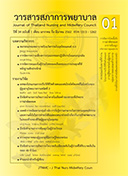Management of Violence Risk in Workplaces: Emergency Departments
Keywords:
workplace violence, emergency department, risk managementAbstract
Workplace violence refers to any act that physically or psychologically threatens any of a workplace’s staff during their operation, whether directly or indirectly. Violence in an emergency department, which could range from physical assaults to verbal abuse, negatively affects the service providers, the clients, and the entire organisation. To ensure effective risk management, it is imperative that the organisation’s administrators, the department-managing nurses, the department’s staff, and the hospital’s security staff be engaged in the process of hospital violence prevention and control.
This article attempts to describe workplace violence in terms of its defnition, types, risk factors, and effects. To contribute to more competent management of violence risk in emergency departments, the article also proposes guidelines for better prevention of violence, as well as effective management during and after an act of violence.
Downloads
References
violence in hospital. 2nded. Department of medical service: Ministry of Public Health; 2018. (in Thai)
2.Abdellah RF, Salama KM. Prevalence and risk factors of workplace violence against health care workers in
emergency department in Ismailia, Egypt. Pan Afr Med J 2017; 26(1): 1-8.
3. Phillips JP. Workplace violence against health care workers in the United States. N Engl J Med. 2016; 374(17): 1661-9.
4.Occupational Safety and Health Administration. Guidelines for preventing workplace violence for healthcare and social service workers [internet]. 2016[cited2018May20].Availablefrom:https:// www.osha.gov/Publications/osha3148.pdf7
5.Saimai W,Thanjira S, PhasertsukjindaN. Workplace violence and its management by nursing personnel
in emergency department. Ramathibodi Nursing Journal 2016; 16(1): 121- 35 (in Thai)
6.Federation of Doctors ofCentralandGeneralHospitals. Workplace violence: case of experience in hospital
[internet]. 2018 [cited 2018 September 20]. Available from: https://www.thaihospital.org/board2/index. php?topic=30340.0 (in Thai)
7. Albashtawy M, Aljezawi M. Emergency nurses’ perspective of workplace violence in Jordanian hospitals:
a national survey. Int Emerg Nurs 2016; 24: 61-5.
8. Albashtawy M, Al-Azzam M, Rawashda A, Batiha AM, Bashaireh I, Sulaiman M. Workplace violence towardemergencydepartmentstaffinJordanianhospitals: across-sectionalstudy.JNursRes2015;23(1):75-81.
9. Koh WM. Management of work place bullying in hospital: a review of the use of cognitive rehearsal as an alternative management strategy. Int J Nurs Sci 2016; 3(2): 213-22.
10.World Health Organization. Violence against health workers [internet]. 2018 [cited 2018 May 20]. Available from: https://www.who.int/violence_injury_prevention/violence/workplace/en/
11.Gillespie GL, Pekar B, Byczkowski TL, Fisher BS. Worker, workplace, and community/environmental
risk factors for workplace violence in emergency departments. Arch Environ Occup health 2017; 72(2): 79-86.
12.Copeland D, Henry M. Workplace violence and perceptions of safety among emergency department
staff members: experiences, expectations, tolerance, reporting, and recommendations. J Trauma Nurs
2017; 24(2): 65-77.
13.Jiao M, Ning N, Li Y, Gao L, Cui Y, Sun H, et al. WorkplaceviolenceagainstnursesinChinesehospitals:
a cross-sectional survey. BMJ 2015; 5(3): 1-9.
14.Morken T, Johansen IH, Alsaker K. Dealing with workplace violence in emergency primary health care: a focus group study. BMC Fam Pract 2015; 16(1); 51-62.
15. Arnetz JE, Hamblin L, Russell J, Upfal MJ, Luborsky, M, Janisse J, et al. Preventing patient-to-worker violence in hospitals: outcome of a randomized controlled intervention. JOccupEnvironMed 2017;59(1):18-27.
16.Pai HC, Lee S. Risk factors for workplace violence in clinical registered nurses in Taiwan. J Clin Nurs 2011; 20(10):1405-12.
17.Eslamian J, Akbarpoor AA, Hoseini SA. Quality of work life and its association with workplace violence
of the nurses in emergency departments. Iran J Nurs Midwifery Res 2015; 20(1): 56-62.
18.Chatziioannidis I, Bascialla FG, Chatzivalsama P, Vouzas F, Mitsiakos G. Prevalence, causes and mental health impact of workplace bullying in the neonatal intensive care unit environment. BMJ open 2017; 8(2): e018766. doi:10.1136/bmjopen-2017-018766.
19.Joint Commission International. Environment of care risk assessment [internet]. 2018 [cited 2018 September
30]. Available from: https://www.jointcommissioninternational.org/environment-of-care-riskassessment-3rd-edition-pdf-book-/.
20.Luck L, Jackson D, Usher K. STAMP: components of observable behaviour that indicate potential for
patient violence in emergency department. J Adv Nurs 2007; 59(1):11-9.
21.Han CY, Lin CC, Barnard A, Hsiao YC, Goopy S, Chen LC. Workplace violence against emergency nurses in Taiwan: a phenomenographic study [internet]. 2017 [cited 2018 May 20]. Available from: https:// www.nursingoutlook.org/article/S0029-6554(16)30400-6/pdf
22.Ramacciati N, Ceccagnoli A, Addey B, Lumini E, Rasero L. Interventions to reduce the risk of violence
toward emergency department staff: current approaches. Open Access Emerg Med 2016; 8: 17-27.








